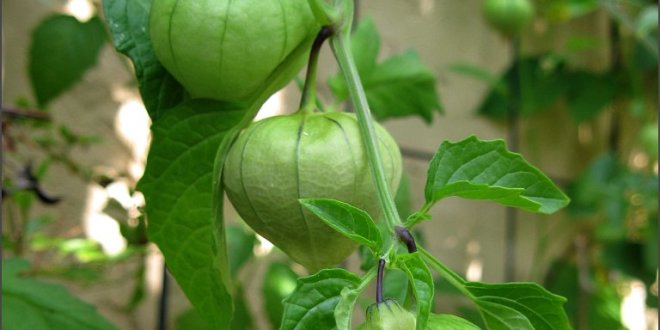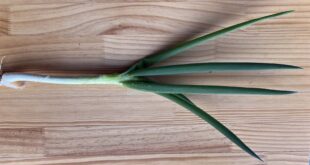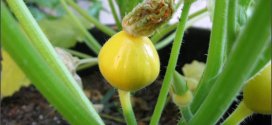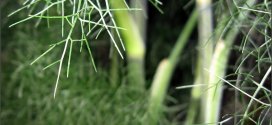If you’ve sampled a salsa or jam containing these green wonders, you should consider adding tomatillo (toh-mah-tee-yo) plants to your garden. Most years we grow a couple of tomatillo plants along with our tomatoes. Our 2019 tomatillo plants are courtesy of a Sunnyvale garden meetup.
Originating in Mexico and Central America, this citrusy plant has been an important food crop for thousands of years. Also historical records show that North American native tribes used these wild fruits to treat headache and stomachache. Fictitious accounts suggest that maize was domesticated so that the natives would have something to eat with their salsa verde.
Prized for their unusual flavor and bright green color, these tangy fruits are now cultivated and enjoyed around the world. They can be eaten raw but most commonly are cooked.
VARIETIES
Tomatillos are part of the nightshade (Solanaceae) family, along with tomatoes, eggplants, and peppers.
Toma Verde is among the more common cultivars, producing the classic, golf ball-sized green fruit. Grande Rio Verde is another variety, producing a larger, 2-3” sweet sphere. Seeds are available from Mountain Valley Seed Co.
A number of purple types also exist, including Purple Coban, Tiny from Coban, and De Milpa.
And a special variety called Amarylla produces immature green fruit that are only ready to harvest once they turn yellow, contrary to the usual harvesting advice (see below). The Amarylla is known to do well for gardeners in northern zones.
GROWING YOUR OWN
In North America, tomatillos are grown as an annual.
As their popularity spreads, seedlings are becoming more commonly available at local garden centers, though not always at big box stores. You can also mail order seeds and propagate your own.
If you go the seed route, start them indoors six to eight weeks before the last frost is expected in your area.
Because tomatillos are not self-pollinating, they must be planted in groups of at least two to ensure fruiting.
Most gardeners find 2-4 plants produce enough fruit for plenty of salsa verde. The plants’ bright yellow flowers will attract bees and other pollinators. You might also add nasturtiums or marigolds as companion plants that will attract pollinators.
Work about two inches of compost into the soil, maintaining a neutral pH close to 7.0. You’ll want to thoroughly aerate your soil to improve drainage, and you should grow tomatillo plants in raised beds if you have heavy clay dirt.
Like their cousin the tomato, they want lots of sun, so select a bright location. And as with tomatoes, you’ll encourage strong, healthy plants if you bury 2/3 of each transplant to enable additional root growth from the stem.
Space plants about three feet apart. These semi-determinate plants tend to sprawl — growing to be 3 to 4 feet tall and wide — so you might want to use a trellis, stake, or cage for support.
The vines prefer well-drained soil, and can even tolerate moderate drought conditions. They do best, however, with an inch or so of water per week. They certainly won’t grow well in soaking-wet ground.
Adding a 2- to 3-inch layer of organic mulch is a good idea to conserve soil moisture and suppress weeds.
The vines are well-suited for container growing. Use a 5-gallon pot for each plant. Keep an eye on soil moisture, as container dirt dries out more quickly.
PEST CONTROL
It’s a good idea to plant onions nearby, to help with pest control.
No particular pest is unique to the tomatillo, but their leaves are susceptible to the usual suspects, such as cucumber beetles, potato beetles and other leaf-loving bugs.
Pick them off or use a natural insecticide to keep them away. You may also see aphids, which can be squirted off with a hose.
HARVESTING
The fruit is ready to pluck 75-100 days after transplanting.
Pick them when they fill out their husks and the husks just begin to split. If the fruit is still small and hard and the husk is still quite loose, it is too early to harvest.
Occasionally, the husk won’t split, but turns brown and leathery; this is also a sign that the fruit is ready to be harvested.
If the fruit turns pale yellow, you have waited too long. At this stage, the tasty interior becomes seedier and the flavor loses its distinctive tanginess.
When you’ve identified a fruit ready for harvest, it’s best to cut it from the plant, rather than pull it, which might damage the stem. Compost damaged or overripe fruits.
You can store harvested tomatillos in their husks at room temperature for up to a week or in the refrigerator either loose or in a paper bag for around three weeks. Avoid storing your harvest in plastic.
Peel away the husk before preparing for consumption. As you peel the green orbs, they will feel sticky. Just wash the fruit to remove the tacky residue.
They can also can be frozen whole or sliced, or preserved by canning.
DETAILS
Tomatillo, Husk Tomato, Miltomate, Tomate de Fresadilla, Physalis ixocarpa ‘Supertillo’
- Family: Solanaceae (so-lan-AY-see-ee) (Info)
- Genus: Physalis (fy-SAL-is) (Info)
- Species: ixocarpa (iks-so-KAR-puh) (Info)
- Cultivar: Supertillo
- Category: Vegetables, Tropical/Tender Perennials
- Height: 18-24 in. (45-60 cm)
- Spacing:24-36 in. (60-90 cm)
- Hardiness: USDA Zone 10a, 10b, 11. In Sunnvyale (Zone 9) treat them as annuals
- Sun Exposure: Full Sun
- Bloom Time: Late Spring/Early Summer through early fall
- Foliage: Velvet/Fuzzy-Textured
- Average Water Needs; Water regularly; do not overwater
- Suitable for growing in containers
- Soil pH requirements: 6.1 to 7.8
- Propagation Methods: From seed; sow indoors before last frost
- Seed Collecting: Allow unblemished fruit to ripen; clean and dry seeds
Read more: http://davesgarden.com/guides/pf/go/65057/#ixzz3GhVwmoiq












